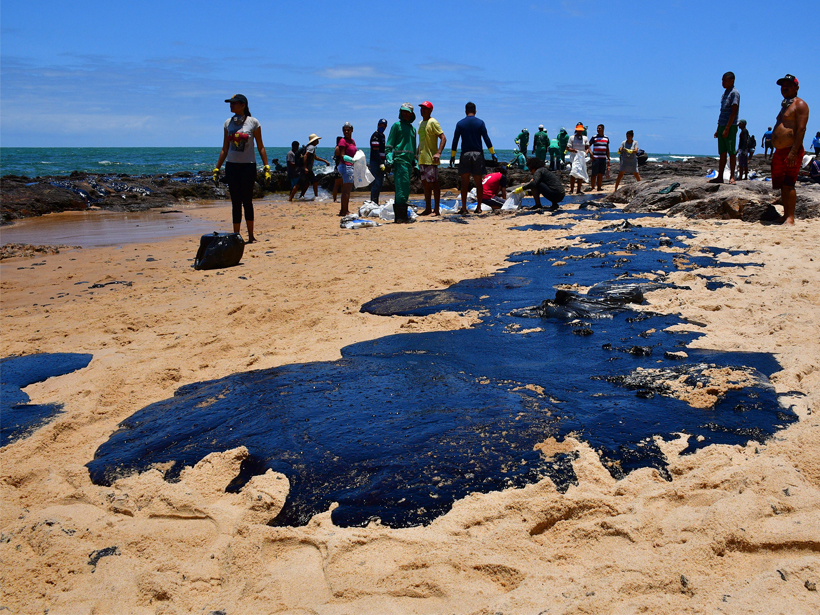The oil is floating beneath the surface of the ocean, making it difficult to track.
Oil is mysteriously washing ashore across more than 2,000 kilometers of sandy beaches in northeast Brazil, and officials aren’t sure of the cause. The oil first appeared on dozens of beaches in early September and has since spread to nine coastal states, forcing beach closures and killing wildlife.
Officials aren’t sure where the oil is from or how much more could be coming. The oil is floating beneath the surface of the ocean, making it difficult to track, and no one has stepped forward to take responsibility for the spill. The Brazilian state oil company, Petrobras, claimed it is not involved, and chemical analysis by Brazil’s environmental agency Ibama suggests that the spill does not match oil from Brazil. A separate analysis of oil chemistry by Brazil’s Federal University of Bahia supported Ibama’s findings.
Venezuela has been indicated as a possible source of the spill.
More tests are being conducted, and some results may be available later this week. Christopher Reddy, a scientist at the Woods Hole Oceanographic Institution (WHOI), received 14 oil samples from Brazil to run on his specialized instrument in Massachusetts. Reddy and his team are analyzing the samples in their comprehensive two-dimensional gas chromatography device to characterize the hydrocarbons present in the oil.
Venezuela has been indicated as a possible source of the spill. Brazil’s environmental minister Ricardo Salles said in early October that the oil was likely from Venezuela, supported by an analysis by Petrobras. An independent analysis by Federal University of Bahia also found a “strong correlation” between the oil spill samples and a type of Venezuelan oil, which Olívia Maria Cordeiro de Oliveira, director of the university’s Geosciences Institute, called “conclusive.”
The Venezuelan state oil company and oil ministry said the statements were “unfounded.”
The signals from Brazilian officials have been mixed, with President Jair Bolsonaro claiming without evidence that the oil is part of criminal activity to stymie an upcoming oil prospecting auction, reports the Washington Post.
Finding the Culprit
Oil carries certain chemical fingerprints, depending on its source material and geologic conditions.
The case may be tough to crack. Researchers analyzing the samples from Brazil are at a “distinct disadvantage,” said Reddy, because the oil has been exposed to the elements. Water dissolves compounds, and sunlight zaps away volatiles, so the oil samples may be modified from the source material.
Oil carries certain chemical fingerprints, depending on its source material and geologic conditions. Oil from Saudi Arabia contains a different chemical makeup than oil from the Gulf of Mexico, for example, and petroleum geochemists publish oil profiles of different reservoirs.
“Old organic matter gets cooked in, squeezed, and made into oil, and that can generate a variety of different outcomes,” Reddy said. Refining processes and other factors also leave imprints on oil’s chemical signature.
The gas chromatography machine used in Reddy’s lab will test the concentrations of roughly a thousand or more hydrocarbons, he said, and will allow his team to create “three-dimensional maps” of the oil’s chemistry. The team uses a “souped-up” version of a gas chromatography machine, he said, which is why his colleagues in Brazil sent him the samples. Internal funding from WHOI provided support to run the experiments.
The first rounds of tests should distinguish if the oil is unrefined or not, said Reddy, meaning it could be either crude oil or some type of refined oil from a ship, like bunker oil. The lab hopes to create a fact sheet of characteristics of the samples.
Reddy cautions that the readouts from the machine won’t be able to tell all the details officials need, such as the country of origin. “I don’t want to get in the middle of saying it’s Venezuelan crude versus a Brazilian crude,” he said.
Teams are finding dead seabirds, turtles, and dolphins covered in oil.
But researchers can’t tell the whole story without working with physical scientists studying ocean currents, said Reddy. One such initiative at the Federal University of Rio de Janeiro is using ocean models to backtrack the oil’s spread in time, according to professor Luiz Paulo Assad.
Meanwhile, volunteers, environmental workers, and troops are clearing beaches with shovels and by hand. More than 4,000 barrels of oil have been removed, and teams are also finding dead seabirds, turtles, and dolphins covered in oil. Scientists are particularly worried about the spill’s possible effects on the upcoming sea turtle migration, when roughly 800,000 olive ridley and loggerhead sea turtles crawl across beaches into the ocean.
—Jenessa Duncombe (@jrdscience), News Writing and Production Fellow
Citation:
Duncombe, J. (2019), Brazil’s oil spill is a mystery, so scientists try oil forensics, Eos, 100, https://doi.org/10.1029/2019EO136177. Published on 24 October 2019.
Text © 2019. AGU. CC BY-NC-ND 3.0
Except where otherwise noted, images are subject to copyright. Any reuse without express permission from the copyright owner is prohibited.
Text © 2019. AGU. CC BY-NC-ND 3.0
Except where otherwise noted, images are subject to copyright. Any reuse without express permission from the copyright owner is prohibited.

